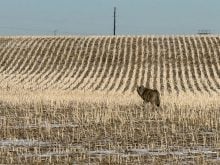Al Scholz was aware that the former Soviet Union countries were heading for a crop wreck long before market analysts started dropping their production estimates.
The former executive director of Saskatchewan Agrivision spent the spring working on a large corporate farm in northern Kazakhstan, where signs of a severe drought were inescapable.
“I have never seen a drought like that,” said Scholz, an agricultural consultant and commentator.
He arrived in Kazakhstan May 1 and departed two months later on July 2.
Scholz was there for seeding and the early growth of the 2010 crop. There was almost no rain in that time, maybe five to six millimetres.
Read Also

Agritechnica Day 3: Hybrid drive for a combine, data standards keep up to tech change and tractors of the year
Agritechnica 2025 Day 3: Hybrid drive for a combine, data standards keep up to tech change and tractors of the year.
“It hardly settled the dust.”
The crops were stunted and starting to wilt by the last week of June. Wheat crops were heading out when they were less than 30 centimetres tall.
Dust storms of up to 80 km/h sandblasted crops, and then flea beetles devoured what was left.
“It was frustrating. We just could not catch a break,” Scholz said.
Kazakhstan’s agriculture ministry is forecasting a 14 million tonne crop, down 33 percent from last year’s record 20.8 million tonnes.
Scholz believes the crop could be smaller. He estimates 10 bushel per acre wheat yields on the 38,300 acre farm where he worked, which would be half of normal.
He was in Kazakhstan as a research agronomist under contract for a Winnipeg consortium of agricultural equipment makers selling product in that country. The consortium is building inland terminals in Kazakhstan and wants to teach farmers how to increase yields to Canadian levels.
Scholz said the agronomic conditions in Kazakhstan are similar to the Canadian Prairies. The area where he worked was the same latitude and had the same parkland setting and frost-free growing days as Rosthern, Sask.
Wheat is the most important crop. Plantings peaked at 48.4 million acres in 1969, plummeted to half that amount shortly after the collapse of the Soviet Union and rebounded to 36.3 million acres in 2009, according to the U.S. Department of Agriculture.
Yields rose 25 percent in the 2000s. Farmers are buying new equipment and receiving government subsidies for their fuel, seed, fertilizer and pesticides. Three-quarters of the harvest is of milling wheat quality in a good year.
Scholz said half of the farms have GPS equipment on their seeders and almost everybody has it on sprayers.
But they aren’t using modern practices like reduced tillage seeding.
The government estimates 60 percent of last year’s grain acres were planted with reduced tillage techniques, but that wasn’t Scholz’s experience.
He said farmers have the equipment but don’t know how to use it and are apathetic about such modern farm management practices.
That lack of education and commitment adds to the severity of this year’s drought.
Scholz once saw a one metre wide drift of “beautifully fine soil” piled up on the edge of a field.
“It just makes you sick.”















